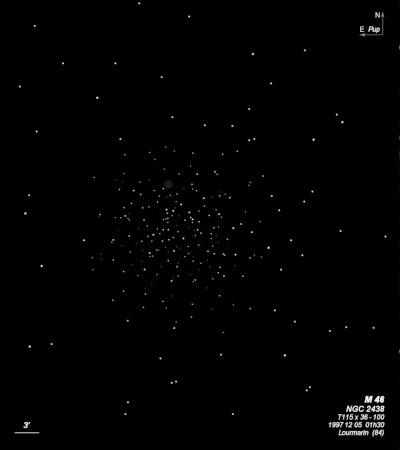
Charles Messier discovered M46 = NGC 2437 = h463 on 19 Feb 1771. Caroline Herschel found it again on 4 Mar 1783 and assumed it was new, realizing her mistake on 19 Nov. William Herschel described the cluster (unpublished) on 19 Mar 1786 as "a beautiful, very rich, compressed cluster of stars of various magnitudes." On 17 Dec 1827 (sweep 111), John Herschel logged, "the brightest part of a v fine rich cl; stars = 10m; which fills the field. Within the cluster at its n edge is a fine planetary nebula [NGC 2438]."
200/250mm - 8" bright, very rich, large, includes a couple of mag 9 stars but most stars are mag 10-13 and fairly uniform in magnitude and distribution except for a gap near the center. Contains the striking pn NGC 2438 at the NE edge. Faint naked-eye object in a dark sky.
400/500mm - 17.5" (3/16/96): At 100x, M46 fills a large portion of the field and there are a few hundred stars fairly evenly distributed in a 35' field. The cluster appears slightly elongated E-W although there are no clear borders. There is no increase in concentration towards the center and except for two brighter stars on the west side the cluster is unusually uniform in brightness (mag 11-13) and distribution in the main body. There is a noticeable 2' void, though, very close to the center of the cluster. Around the periphery the distribution becomes quite scraggly and the cluster mixes with the general field density. The beautiful annular planetary NGC 2438 is situated in the north side of the cluster.
Notes by Steve Gottlieb